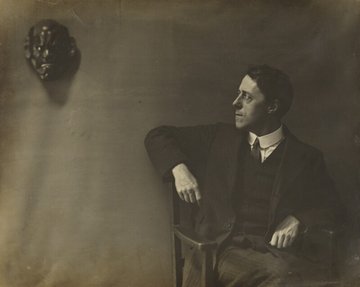
Laurence Binyon
‐
Curator who studied alongside Manmohan Ghose in London
Other names
Robert Laurence Binyon
Place of birth
Place of death
Reading
About
Laurence Binyon was a poet, critic, artist, dramatist and curator. He worked in the British Museum from 1892 till his retirement in 1933 and was instrumental in promoting Asian art in the museum. He was introduced to Indian literature and philosophy by the poet Manmohan Ghose. They met as schoolboys at St Paul's School, in a seventh-form English lesson when Ghose quoted Othello in class. They became fast friends, bonding over their love for poetry and Classics and their admiration of Matthew Arnold. Binyon followed Ghose to Oxford in 1888 (Ghose had joined in 1887) and they were involved in producing a short selection of poems under the title of Primavera in 1890, which was reviewed favourably by, among others, Oscar Wilde in the Pall Mall Gazette.
In 1910 Binyon became involved with the India Society in London, designed to promote Indian fine art. Binyon became friends with the art historian Ananda Coomaraswamy, who introduced him to Rajput paintings. In June 1912 Binyon met Rabindranath Tagore at William Rothenstein's house and held an admiration for Tagore that lasted until his death. Binyon had been introduced to the work of Tagore by Manmohan Ghose, who had returned to India in 1894 but maintained a correspondence for some years – providing inspiration for Binyon's poem 'Asoka' or 'The Indian Prince' in 1900. When Ghose died in 1924, his daughter, Lotika, came to England to meet Binyon and show him her father's manuscripts. This inspired Binyon to write an introductory memoir for an edition of Ghose's poems that was published in 1926 under the title Songs of Love and Death.
Shortly before the Armistice, in November 1918, Binyon met Kedar Nath Das Gupta in London. Das Gupta, a friend of Tagore's, was organizer of the Union of the East and West. He had prepared a rough translation of Sakuntala, which he wished to put on the stage; Binyon agreed to rewrite Kalidasa's play for the stage, and two performances were put on in November 1919, produced by Lewis Casson and starring Sybil Thorndike. In 1920, Binyon gave the inaugural address for the Indian Students' Union and Hostel opened in Gower Street. Another connection to India was realized through Binyon's introduction to the Indian artist Mukul Dey's My Pilgrimages to Ajanta and Bagh (1925). Binyon did not manage to visit India in his lifetime, despite the desire he expressed to the Oxford Majlis society in 1929. Upon his death in 1943, the Oxford Majlis passed a resolution in honour of Binyon as a 'lifelong friend' of India.
Performances of Sakuntala, Winter Garden Theatre, November 1919
Inauguration of Indian Students' Union and Hostel, Gower Street, 1920
Atul Chatterjee, Harindranath Chattopadhyaya, Ananda Coomaraswamy, Arthur Cripps (poet-missionary, contributor to Primavera), Kedar Nath Das Gupta, Mukul Dey, Manmohan Ghose, John Masefield, Henry Newbolt, Stephen Phillips (cousin, contributor to Primavera), Ezra Pound, William Rothenstein, Rabindranath Tagore, Oscar Wilde, William Butler Yeats.
(with Stephen Phillips, Manmohan Ghose and Arthur Cripps) Primavera: Poems by Four Authors (Oxford: Blackwells, 1890)
(with Kedar Nath Das Gupta) Sakuntala (London: Macmillan & Co., 1920)
See Manmohan Ghose, Collected Poems. Volume I: Early Poems and Letters, ed. by Lotika Ghose (Calcutta: University of Calcutta, 1970) for an introductory memoir by Laurence Binyon and a pencil sketch of Ghose aged 23 by Binyon
Hatcher, John, Laurence Binyon: Poet, Scholar of East and West (Oxford: Clarendon Press, 1995)
Gandhi, Leela, Affective Communities: Anticolonial Thought and the Politics of Friendship (New Delhi: Permanent Black, 2006)
Letters to Binyon (including one from Harindranath Chattopadhyaya, and letters from Manmohan Ghose), and a few letters from Laurence Binyon to various correspondents and other unpublished manuscripts, Loan Collection 103, Manuscript Reading Room, British Library, St Pancras
Letters from Binyon to William Rothenstein, Mss Eur B213, Asian and African Studies Reading Room, British Library, St Pancras
Circumstances had prevented him from being like Rabindra Nath Tagore, an interpreter of the West to India. He admired the Bengali language, but it seemed to him lacking in a certain quality which he found in English. No Indian had ever before used our tongue with so poetic a touch, and he would coin a phrase, turn a noun into a verb with the freedom, often the felicity of our own poets. But he remains Indian. I do not think that an Indian reader would feel him as a foreign poet, for all his western tastes and allusions. Yet to us he is a voice among the great company of English singers; somewhat apart and solitary, with a difference in his note, but not an echo.
From Introductory Memoir to Manmohan Ghose, Collected Poems, Volume 1 (1970), pp. xv–xvi.
Image credit
Laurence Binyon by Hector Ernest Murchison, bromide print, circa 1913, NPG x964
© National Portrait Gallery, London, Creative Commons, http://creativecommons.org/licenses/by-nc-nd/3.0/
